ABCs of understanding flashers, fish finders for bass fishing
FLW Tour pro Jim Moynagh takes a comprehensive look at how anglers can optimize their electronics.
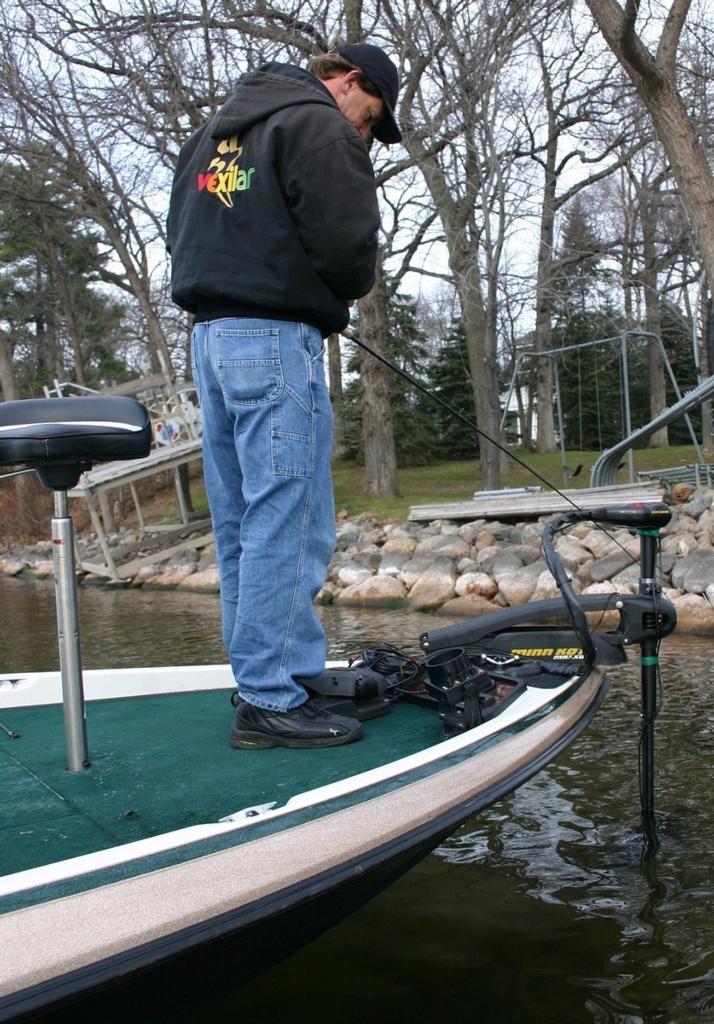
If you follow the world of professional fishing, it is hard not to notice there is a trend back to using flasher technology for fish finders. The use of a flasher-style display uses a rotating wheel that displays the bottom and other targets in a series of lights on that spinning wheel. In contrast to liquid-crystal displays that show a history of what your boat has passed over, a spinning-wheel flasher displays the bottom and targets in real time.
Actually, first-generation spinning-wheel flashers were the first type of portable sonar systems used by fishermen back in the 1960s. A system called the Green Box made by Lowrance was the gold standard for sonar during this period.
Today’s hard-core bass anglers have found some very important reasons to put a spinning-wheel flasher back in the boat. For many readers, a fish finder using spinning-wheel flasher technology is totally new. In fact, a complete generation of anglers have grown up in the era of the liquid-crystal sonar display and don’t know the first thing about what a spinning-wheel flasher unit can do to make them better fishermen.
I should give our readers a little background on the evolution of sonar technology and why the flashers faded from favor with many anglers back in the early 1980s. The advancements of the LCDs amazed many anglers. They were now able to see a rough picture of what the bottom looks like and that was a big deal. In fact, they could even display little fish symbols while they were fishing. The technical and financial commitment of the major sonar makers into LCD systems rather than the next generation of spinning-wheel flashers spawned an almost complete elimination of the latter type of fish finder.
Only a 45-year-old sonar company in Minneapolis called Vexilar realized the potential of flasher technology for fish finders. Unfortunately, it was not for bass fishing; ice fishing kept this technology growing and developing. In Minnesota, the winters are long and cold. Liquid-crystal sonar would freeze, but the next generation of spinning-wheel flashers from Vexilar performed without fail. You see, the next generation of flashers did not use the fragile, single-color neon bulbs but used a combination of light-emitting diodes with colors. This breakthrough came with little fanfare to bass fishermen. The bass world was focused on looking at symbols of little fish and seeing a digital readout of the bottom. Anglers were willing to give up the real-time response of flasher sonar for a history of what their boat had passed over.
Simply put, the new generation of fish finders using LEDs and spinning-wheel flasher technology deliver performance and benefits that the now-popular liquid-crystal sonar units cannot. Are flashers better than a LCD? Maybe not, but they do offer information that cannot be shown on most LCDs, and I have found that it can definitely help some anglers catch more fish. This is the reason flashers have re-gained a spot in the boat for many of the nation’s top bass anglers, even while they still have a liquid-crystal sonar displayed in their boats.
Think about the need for real-time response. The modern bass boat is getting faster and faster, while the image-processing speeds of the LCDs are getting slower and slower. At 70 mph, the delay in display time on a new color LCD, now called TFT, might be up to be 50 yards off before you even know the depth changed. A spinning-wheel flasher is almost instantaneous in its display. Even if you are trying to fish a brush pile, the display from a liquid crystal makes it almost impossible to hold the boat over the edge of the brush since the boat will drift over it and your LCD only shows the brush after you have drifted over the edge. The flasher will allow you to fish individual limbs on a brush pile.
Don’t be confused by attempts from some companies to create an LCD of a flasher wheel. This is done to give the angler the feeling that it performs like a spinning-wheel flasher, but don’t be fooled. The processing time of an LCD is just as fast as if it is in the normal shape of a TV-size display or shaped to look like a spinning-wheel flasher display. Many avid spinning-wheel flasher fans are very critical of the performance of this copycat display. Because of the time delay between when the copycat unit receives and displays the signal, it is almost impossible to use it like a true spinning-wheel flasher.
The best way to explain the benefits of a fish finder that uses spinning-wheel flasher technology is to actually show you images of the flasher in use. This also helps to explain why they are superior to LCDs for some fishing situations.
Shallow-water performance
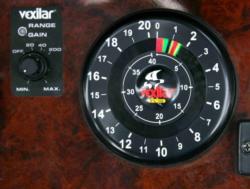 If you own an LCD sonar now, you might think it is impossible to display a signal in less than a foot of water. Some of the nation’s most popular liquid-crystal sonar systems that come standard on some bass boats from the factory do not even show you a bottom signal until you are in 5 feet of water. This photo shows the Vexilar FL-10 displaying the true bottom depth in less than a foot of water. If you’re fishing a dirty-water lake or river system, it is critical sometimes to know if you are fishing in 1, 2 or 3 feet of water. The flasher sonar is designed to perform in supershallow water.
If you own an LCD sonar now, you might think it is impossible to display a signal in less than a foot of water. Some of the nation’s most popular liquid-crystal sonar systems that come standard on some bass boats from the factory do not even show you a bottom signal until you are in 5 feet of water. This photo shows the Vexilar FL-10 displaying the true bottom depth in less than a foot of water. If you’re fishing a dirty-water lake or river system, it is critical sometimes to know if you are fishing in 1, 2 or 3 feet of water. The flasher sonar is designed to perform in supershallow water.
Thick vegetation
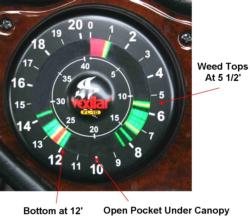 Here is where the Vexilar FL-10 three-color flasher and fish finder excels. If you have fished deep grass or milfoil beds, you know what I’m talking about here. A standard liquid crystal might show your boat in 5 or 6 feet of water, but actually you are in 12, with 6 feet of weeds. Using a Vexilar Flasher is the unfair advantage for many Texas anglers who have discovered how to find pockets in the canopy of vegetation for flipping jigs. The three-color design of the Vexilar allows the angler to better understand where the open pockets will be, and in some situations, it is not on the bottom. This view clearly shows the top of the weeds in green. Green signals are the weakest and can be used to identify weeds or even small fish targets on the outer edge of the transducer cone. As targets get stronger, they turn to orange and then to red that shows, in this case, bottom. Some of the superdeep grass anglers of West Texas can actually see red targets of bass in the deep weeds that might run down to 30 feet.
Here is where the Vexilar FL-10 three-color flasher and fish finder excels. If you have fished deep grass or milfoil beds, you know what I’m talking about here. A standard liquid crystal might show your boat in 5 or 6 feet of water, but actually you are in 12, with 6 feet of weeds. Using a Vexilar Flasher is the unfair advantage for many Texas anglers who have discovered how to find pockets in the canopy of vegetation for flipping jigs. The three-color design of the Vexilar allows the angler to better understand where the open pockets will be, and in some situations, it is not on the bottom. This view clearly shows the top of the weeds in green. Green signals are the weakest and can be used to identify weeds or even small fish targets on the outer edge of the transducer cone. As targets get stronger, they turn to orange and then to red that shows, in this case, bottom. Some of the superdeep grass anglers of West Texas can actually see red targets of bass in the deep weeds that might run down to 30 feet.
Anglers can use this display to find where the opening in the weeds will occur. Here you can even see the opening under a large clump of milfoil. The bass can be holding just below this canopy, and many anglers fishing without a flasher will simply drop their jigs right past them. And unless they are very hot fish, these anglers miss a prime opportunity. With a flasher, you can hold the boat over these hidden pockets and fish your baits in the sweet spot …very cool indeed.
Targeting hard or soft bottom areas
The more anglers understand bottom makeup, the more they start to realize fish relate to the things that offer what they need. In the spring, they might prefer soft bottom areas, where vegetation is starting to grow and where the bottom tends to absorb more sunlight. In the summer, they might target hard bottom areas that are holding crayfish. Flashers make it easy to know if you are fishing above hard or soft bottom areas, and you are able to pinpoint the exact areas where the soft or hard bottom areas begin.
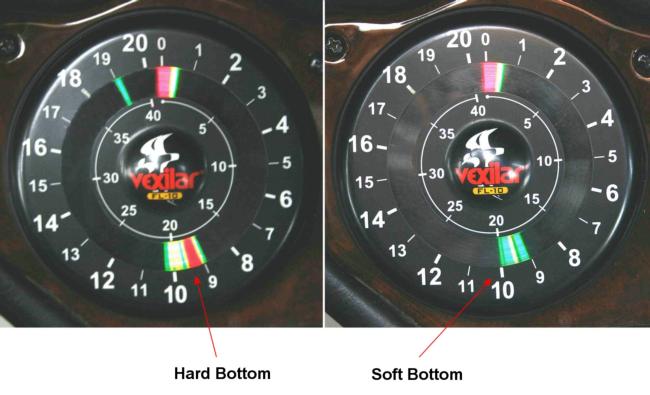 In this photo you will see how, within 10 yards of each view, the bottom went from hard rock to supersoft mud. The signal shows a bright red band for the bottom, so you can spot a hard bottom, but with the Vexilar three-color systems, you are able to see how the bottom softens and the colors change all the way to green, which means a very weak signal.
In this photo you will see how, within 10 yards of each view, the bottom went from hard rock to supersoft mud. The signal shows a bright red band for the bottom, so you can spot a hard bottom, but with the Vexilar three-color systems, you are able to see how the bottom softens and the colors change all the way to green, which means a very weak signal.
Too much power
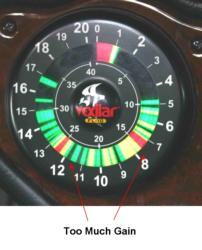 For many years, manufacturers would stress to anglers that, if you wanted to get more information on your LCD, you were to turn off the auto gain setting and manually turn up the gain. Not so with Vexilar Flashers, since there is no auto gain setting. Photo No. 4 shows how you can simply light up your display if you have your gain turned up too high, which then shows everything and that will confuse any angler. So turn down the gain until you can clearly spot bottom and you are good to go. In most cases with a Vexilar Flasher, the lowest gain setting is best, because Vexilar sonar systems offer the most sensitive receivers in the industry.
For many years, manufacturers would stress to anglers that, if you wanted to get more information on your LCD, you were to turn off the auto gain setting and manually turn up the gain. Not so with Vexilar Flashers, since there is no auto gain setting. Photo No. 4 shows how you can simply light up your display if you have your gain turned up too high, which then shows everything and that will confuse any angler. So turn down the gain until you can clearly spot bottom and you are good to go. In most cases with a Vexilar Flasher, the lowest gain setting is best, because Vexilar sonar systems offer the most sensitive receivers in the industry.
Will the spinning-wheel Vexilar Flasher like the FL-10 in-Dash, FL-8 or FL-18 help you catch more fish? Well, if you ask any true “flasher guy” out there, he will say he feels far more confident he can find and stay on fish holding cover better with a flasher than any other type of sonar display. It is my firm belief that it will not be long before a national bass tournament victory will be credited to the flasher directly and not some secret lure or hot spot. Serious tournament anglers know that being able to have great boat control around structure is a sure-fire receipt to put more fish in the boat.